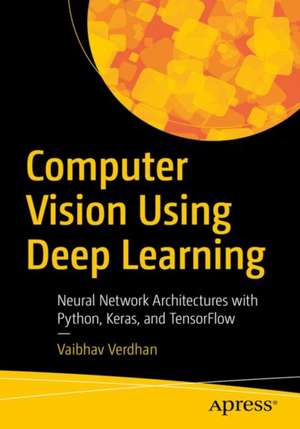Computer Vision Using Deep Learning: Neural Network Architectures with Python and Keras
Autor Vaibhav Verdhanen Limba Engleză Paperback – 15 feb 2021
This book will bring into focus these and other deep learning architectures and techniques to help you create solutions using Keras and the TensorFlow library. You'll also review mutliple neural network architectures, including LeNet, AlexNet, VGG, Inception, R-CNN, Fast R-CNN, Faster R-CNN, Mask R-CNN, YOLO, and SqueezeNet and see how they work alongside Python code via best practices, tips, tricks, shortcuts, and pitfalls. All code snippets will be broken down and discussed thoroughly so you can implement the same principles in your respective environments.
Computer Vision Using Deep Learning offers a comprehensive yet succinct guide that stitches DL and CV together to automate operations, reduce human intervention, increase capability, and cut the costs.
What You'll Learn
- Examine deep learning code and concepts to apply guiding principals to your own projects
- Classify and evaluate various architectures to better understand your options in various use cases
- Go behind the scenes of basic deep learning functions to find out how they work
Professional practitioners working in the fields of software engineering and data science. A working knowledge of Python is strongly recommended. Students and innovators working on advanced degrees in areas related to computer vision and Deep Learning.
Preț: 261.72 lei
Preț vechi: 327.15 lei
-20% Nou
Puncte Express: 393
Preț estimativ în valută:
50.09€ • 54.39$ • 42.07£
50.09€ • 54.39$ • 42.07£
Carte disponibilă
Livrare economică 01-15 aprilie
Preluare comenzi: 021 569.72.76
Specificații
ISBN-13: 9781484266151
ISBN-10: 1484266153
Pagini: 308
Ilustrații: XXI, 308 p. 151 illus., 115 illus. in color.
Dimensiuni: 155 x 235 mm
Greutate: 0.51 kg
Ediția:1st ed.
Editura: Apress
Colecția Apress
Locul publicării:Berkeley, CA, United States
ISBN-10: 1484266153
Pagini: 308
Ilustrații: XXI, 308 p. 151 illus., 115 illus. in color.
Dimensiuni: 155 x 235 mm
Greutate: 0.51 kg
Ediția:1st ed.
Editura: Apress
Colecția Apress
Locul publicării:Berkeley, CA, United States
Cuprins
Chapter 1Introduction to Computer Vision and Deep Learning.- Chapter 2Nuts and Bolts of Deep Learning for Computer Vision.- Chapter 3Image Classification using LeNet.- Chapter 4 VGGNet and AlexNext Networks.- Chapter 5Object Detection Using Deep Learning.- Chapter 6Facial Recognition and Gesture Recognition.- Chapter 7 Video Analytics Using Deep Learning.- Chapter 8End-to-end Model Development.- Appendix.
Notă biografică
Vaibhav Verdhan is a seasoned data science professional with rich experience spanning across geographies and retail, telecom, manufacturing, health-care and utilities domain. He is a hands-on technical expert and has led multiple engagements in Machine Learning and Artificial Intelligence. He is a leading industry expert, is a regular speaker at conferences and meet-ups and mentors students and professionals. Currently he resides in Ireland and is working as a Principal Data Scientist.
Textul de pe ultima copertă
Organizations spend huge resources in developing software that can perform the way a human does. Image classification, object detection and tracking, pose estimation, facial recognition, and sentiment estimation all play a major role in solving computer vision problems.
This book will bring into focus these and other deep learning architectures and techniques to help you create solutions using Keras and the TensorFlow library. You'll also review mutliple neural network architectures, including LeNet, AlexNet, VGG, Inception, R-CNN, Fast R-CNN, Faster R-CNN, Mask R-CNN, YOLO, and SqueezeNet and see how they work alongside Python code via best practices, tips, tricks, shortcuts, and pitfalls. All code snippets will be broken down and discussed thoroughly so you can implement the same principles in your respective environments.
Computer Vision Using Deep Learning offers a comprehensive yet succinct guide that stitches DL and CV together to automate operations, reduce human intervention, increase capability, and cut the costs.
You will:
This book will bring into focus these and other deep learning architectures and techniques to help you create solutions using Keras and the TensorFlow library. You'll also review mutliple neural network architectures, including LeNet, AlexNet, VGG, Inception, R-CNN, Fast R-CNN, Faster R-CNN, Mask R-CNN, YOLO, and SqueezeNet and see how they work alongside Python code via best practices, tips, tricks, shortcuts, and pitfalls. All code snippets will be broken down and discussed thoroughly so you can implement the same principles in your respective environments.
Computer Vision Using Deep Learning offers a comprehensive yet succinct guide that stitches DL and CV together to automate operations, reduce human intervention, increase capability, and cut the costs.
You will:
- Examine deep learning code and concepts to apply guiding principles to your own projects
- Classify and evaluate various architectures to better understand your options in various use cases
- Go behind the scenes of basic deep learning functions to find out how they work
Caracteristici
Implement Deep Learning solutions on your own systems to bridge the gap between theory and practice Examine the inner workings of the codes and libraries that make Deep Learning applications work Create solutions for computer vision design using Keras and TensorFlow
